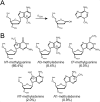An HPLC-tandem mass spectrometry method for simultaneous detection of alkylated base excision repair products
- PMID: 23876937
- PMCID: PMC3812247
- DOI: 10.1016/j.ymeth.2013.07.020
An HPLC-tandem mass spectrometry method for simultaneous detection of alkylated base excision repair products
Abstract
DNA glycosylases excise a broad spectrum of alkylated, oxidized, and deaminated nucleobases from DNA as the initial step in base excision repair. Substrate specificity and base excision activity are typically characterized by monitoring the release of modified nucleobases either from a genomic DNA substrate that has been treated with a modifying agent or from a synthetic oligonucleotide containing a defined lesion of interest. Detection of nucleobases from genomic DNA has traditionally involved HPLC separation and scintillation detection of radiolabeled nucleobases, which in the case of alkylation adducts can be laborious and costly. Here, we describe a mass spectrometry method to simultaneously detect and quantify multiple alkylpurine adducts released from genomic DNA that has been treated with N-methyl-N-nitrosourea (MNU). We illustrate the utility of this method by monitoring the excision of N3-methyladenine (3 mA) and N7-methylguanine (7 mG) by a panel of previously characterized prokaryotic and eukaryotic alkylpurine DNA glycosylases, enabling a comparison of substrate specificity and enzyme activity by various methods. Detailed protocols for these methods, along with preparation of genomic and oligonucleotide alkyl-DNA substrates, are also described.
Keywords: 1,N(6)-ethenoadenine; 1mA; 3mA; 4-(2-hydroxyethyl)-1-piperazineethanesulfonic acid; 6-carboxyfluorescein; 7mG; AAG; AlkA; Alkylation; BSA; Base excision repair; CID; DMS; DNA glycosylase; DTT; E. coli 3-methyladenine DNA glycosylase I; E. coli 3-methyladenine DNA glycosylase II; EDTA; ESI; ESI(+); FAM; HEPES; HPLC; MAG; MMS; MNNG; MNU; MRM; MS/MS; Mass spectrometry; Methylpurine; N-methyl-N-nitrosourea; N-methyl-N′-nitro-N-nitrosoguanidine; N1-methyladenine; N3-methyladenine; N7-methylguanine; TAG; Tris; bovine serum albumin; collision induced dissociation; dimethylsulfate; dithiothreitol; electrospray ionization; ethylenediaminetetraacetic acid; high performance liquid chromatrography; human alkyladenine DNA glycosylase; methyladenine DNA glycosylase; methylmethanesulfonate; multiple reaction monitoring; positive ion mode electrospray ionization; tandem mass spectrometry; tris(hydroxymethyl)aminomethane; εA.
Copyright © 2013 Elsevier Inc. All rights reserved.
Figures




Similar articles
-
Selective base excision repair of DNA damage by the non-base-flipping DNA glycosylase AlkC.EMBO J. 2018 Jan 4;37(1):63-74. doi: 10.15252/embj.201797833. Epub 2017 Oct 20. EMBO J. 2018. PMID: 29054852 Free PMC article.
-
Purification and properties of the alkylation repair DNA glycosylase encoded the MAG gene from Saccharomyces cerevisiae.Biochemistry. 1995 Apr 11;34(14):4577-82. doi: 10.1021/bi00014a010. Biochemistry. 1995. PMID: 7718559
-
Hepsulfam induced DNA adducts and its excision repair by bacterial and mammalian 3-methyladenine DNA glycosylases.Mol Cells. 1998 Dec 31;8(6):691-7. Mol Cells. 1998. PMID: 9895121
-
Structural studies of human alkyladenine glycosylase and E. coli 3-methyladenine glycosylase.Mutat Res. 2000 Aug 30;460(3-4):201-10. doi: 10.1016/s0921-8777(00)00027-6. Mutat Res. 2000. PMID: 10946229 Review.
-
Archaeal DNA alkylation repair conducted by DNA glycosylase and methyltransferase.Appl Microbiol Biotechnol. 2023 May;107(10):3131-3142. doi: 10.1007/s00253-023-12506-3. Epub 2023 Apr 10. Appl Microbiol Biotechnol. 2023. PMID: 37036526 Review.
Cited by
-
Strategies for the evaluation of DNA damage and repair mechanisms in cancer.Oncol Lett. 2017 Jun;13(6):3982-3988. doi: 10.3892/ol.2017.6002. Epub 2017 Apr 6. Oncol Lett. 2017. PMID: 28588692 Free PMC article.
-
An interstrand DNA crosslink glycosylase aids Acinetobacter baumannii pathogenesis.Proc Natl Acad Sci U S A. 2024 Jul 2;121(27):e2402422121. doi: 10.1073/pnas.2402422121. Epub 2024 Jun 26. Proc Natl Acad Sci U S A. 2024. PMID: 38923984 Free PMC article.
-
Selective base excision repair of DNA damage by the non-base-flipping DNA glycosylase AlkC.EMBO J. 2018 Jan 4;37(1):63-74. doi: 10.15252/embj.201797833. Epub 2017 Oct 20. EMBO J. 2018. PMID: 29054852 Free PMC article.
-
Resistance-Guided Mining of Bacterial Genotoxins Defines a Family of DNA Glycosylases.mBio. 2022 Apr 26;13(2):e0329721. doi: 10.1128/mbio.03297-21. Epub 2022 Mar 21. mBio. 2022. PMID: 35311535 Free PMC article.
-
Structure of a DNA glycosylase that unhooks interstrand cross-links.Proc Natl Acad Sci U S A. 2017 Apr 25;114(17):4400-4405. doi: 10.1073/pnas.1703066114. Epub 2017 Apr 10. Proc Natl Acad Sci U S A. 2017. PMID: 28396405 Free PMC article.
References
-
- Friedberg E, Walker G, Siede W, Wood R, Schultz R, T E. DNA Repair and Mutagenesis. 2nd. ASM Press; Washimgton, DC: 2006.
-
- Lawley P. In: Chemical Carcinogens. Searle CE, editor. American Chemical Society; Washington, D.C.: 1976. pp. 325–484.
-
- Sedgwick B. Nat Rev Mol Cell Biol. 2004;5:148–157. - PubMed
-
- Fromme JC, Banerjee A, Verdine GL. Curr Opin Struct Biol. 2004;14:43–49. - PubMed
Publication types
MeSH terms
Substances
Grants and funding
LinkOut - more resources
Full Text Sources
Other Literature Sources
Research Materials

